RBSE Solutions for Class 12 Maths Chapter 13 Probability Ex 13.2
Rajasthan Board RBSE Solutions for Class 12 Maths Chapter 13 Probability Ex 13.2 Textbook Exercise Questions and Answers.
Rajasthan Board RBSE Solutions for Class 12 Maths in Hindi Medium & English Medium are part of RBSE Solutions for Class 12. Students can also read RBSE Class 12 Maths Important Questions for exam preparation. Students can also go through RBSE Class 12 Maths Notes to understand and remember the concepts easily.
RBSE Class 12 Maths Solutions Chapter 13 Probability Ex 13.2
Question 1.
If P(A) = \(\frac{3}{5}\) and P(B) = \(\frac{1}{5}\), find P(A ∩ B) if A and B are independent events.
Answer:
It is given that,
P(A) = \(\frac{3}{5}\) and P(B) = \(\frac{1}{5}\)
A and B are independent events.
Therefore
P(A ∩ B) = P(A) . P(B)
= \(\frac{3}{5} \cdot \frac{1}{5}=\frac{3}{25}\)
Question 2.
Two cards are drawn at random and without replacement from a pack of 52 playing cards. Find the probability that both the cards are black.
Answer:
There are 26 black cards in a deck of 52 cards.
Let P(A) be the probability of getting a black card in the first draw.
∴ P(A) = \(\frac{26}{52}=\frac{1}{2}\)
Let P(B) be the probability of getting a black card on the second draw.
Since the card is not replaced,
∴ P(B) = \(\frac{25}{51}\)
Thus, probability of getting both the cards black
= \(\frac{1}{2} \times \frac{25}{51}=\frac{25}{102}\)

Question 3.
A box of oranges is inspected by examining three randomly selected oranges drawn without re-placement. If all the three oranges are good, the box is approved for sale, otherwise, it is rejected. Find the probability that a box containing 15 oranges out of which 12 are good and 3 are bad ones will be approved for sale.
Answer:
Let A, B and C be the respective events that the first, second, and third drawn orange is good.
Therefore, probability that first drawn orange is good,
P(A) = \(\frac{12}{15}\)
The oranges are not replaced.
Therefore, probability of getting second orange good,
P(B) = \(\frac{11}{14}\)
Similarly, probability of getting third orange good
P(C) = \(\frac{10}{13}\)
The box is approved for sale, if all the three oranges are good.
Thus, probability of getting all the oranges good
= \(\frac{12}{15} \times \frac{11}{14} \times \frac{10}{13}=\frac{44}{91}\)
Therefore, the probability that the box is approved for sale is \(\frac{44}{91}\).
Question 4.
A fair coin and an unbiased die are tossed. Let A be the event 'head appears on the coin' and B be the event '3 on the die'. Check whether A and B are independent events or not.
Answer:
If a fair coin and an unbiased die are tossed, then the sample space S is given by,

Let A : Head appears on the coin
A = {(H, 1), (H, 2), (H, 3), (H, 4), (H,5),(H,6)}
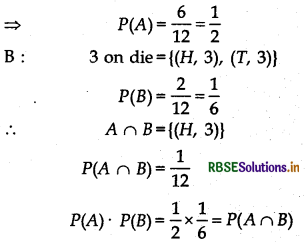
Therefore, E and F are not independent.
Question 5.
A die marked 1, 2, 3 in red and4, 5, 6 in green is tossed. Let A be the event, ‘the number is event and B be the event, ‘the number is red’. Are A and B independent?
Answer:
When a die is thrown, the sample space (S) is
S = {1, 2, 3, 4, 5, 6}
Let A : the number is even = {2, 4, 6}
⇒ P(A) = \(\frac{3}{6}=\frac{1}{2}\)
B: the number is red = {1, 2, 3}
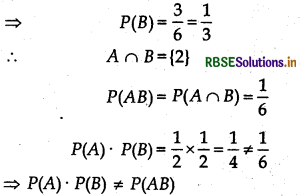
Therefore, A and B are not independent.
Question 6.
Let E and F be events with P(E) = \(\frac{3}{5}\), P(F) = \(\frac{3}{10}\) and P(E ∩ F) = \(\frac{1}{5}\). Are E and F independent?
Answer:
It is given that
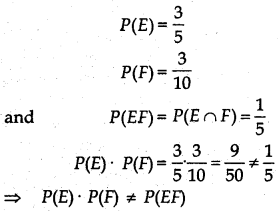
Therefore, E and F are not independent.

Question 7.
Given that the events A and B are such that P(A) = \(\frac{1}{2}\), P(A ∪ B) = \(\frac{3}{5}\), and P(B) = p. Find p if they are (i) mutually exclusive (ii) independent.
Answer:
It is given that
P(A) = \(\frac{1}{2}\)
P(A ∩ B) = \(\frac{3}{5}\)
and P(B) = p
(j) When A and B are mutually exclusive,
A ∩ B = Φ
P(A ∩ B) = 0
It is known that,
P(A ∪ B) = P(A) + P(B) - P(A ∩ B)
⇒ \(\frac{3}{5}=\frac{1}{2}\) + p = 0
⇒ p = \(\frac{3}{5}-\frac{1}{2}=\frac{1}{10}\)
(ii) When A and B are independent,
P(A ∩ B) = P(A).P(B) = \(\frac{1}{2}\)p
It is known that,
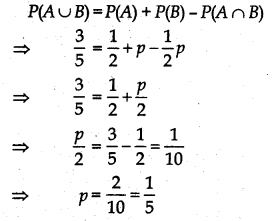
Question 8.
Let A and B be independent events with P(A) = 0.3 and P(B) = 0.4. Find :
(i) P(A ∩ B)
(ii) P(A ∪ B)
(iii) P(A/B)
(iv) P(B/A)
Answer:
It is given that:
P(A) = 0.3
P(B) = 0.4
(i) If A and B are independent events, then
P(A ∩ B) = P(A) P(B)
= 03 × 0.4 = 0.12
(ii) It is known that,
P(A ∪ B) = P(A) + P(B) - P(A ∩ B)
⇒ P(A ∪ B) = 0.3 + 0.4 - 0.12 = 0.58
(iii) It is known that,
P(A/B) = \(\frac{P(A \cap B)}{P(B)}\)
⇒ P(A/B) = \(\frac{0.12}{0.4}\) = 0.3
(iv) It is known that
P(B/A) = \(\frac{P(A \cap B)}{P(A)}\)
⇒ P(B/A) = \(\frac{0.12}{0.3}\) = 0.4
Question 9.
If A and B are two events such that P(A) = \(\frac{1}{4}\), P(B) = \(\frac{1}{2}\) and P(A ∩ B) = \(\frac{1}{8}\) find P (not A and not B).
Sol. It is given that,
P(A) = \(\frac{1}{2}\) and P(A ∩ B) = \(\frac{1}{8}\)
P (not on A and not on B)
= P(A' ∩ B')
P(not on A and not on B)
= P((A ∪ B))' [A' ∩ B'= (A ∪ B)']
= 1 - P(A ∪ B)
= 1 - [P(A) + P(B) - P(A ∩ B)]
= 1 - \(\left[\frac{1}{4}+\frac{1}{2}-\frac{1}{8}\right]\)
= 1 - \(\frac{5}{8}=\frac{3}{8}\)

Question 10.
Events A and B are such that P(A) = \(\frac{1}{2}\) P(B) = \(\frac{7}{12}\) and P (not A or not B) = \(\frac{1}{4}\). State whether
A and B are independent?
Answer:
It is given that,
P(A) = \(\frac{1}{2} \)
P(B) = \(\frac{7}{12}\)
and P (not A or not B) = \(\frac{1}{4}\)
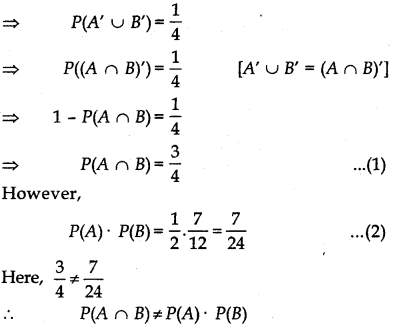
Question 11.
Given two independent events A and B such that P(A) = 0.3, P(B) = 0.6.
Find (i) P(A and B)
(ii) P(A and not B)
(iii) P(A or B)
(iv) P(neither A nor B)
Answer:
It is given that,
P(A) = 0.3 and P(B) = 0.6
Also, A and B are independent events.
(i) ∴ P(A and B)=P(A)- P(B)
⇒ P(A ∩ B) = 0.3 × 0.6 = 0.18
(ii) P(A and not B) = P(A ∩ B')
= P(A) - P(A ∩ B)
= 0.3 - 0.18
= 0.12
(iii) P(A or B) = P(A ∪ B)
= P(A) + P(B) - P(A ∩ B)
= 0.3 + 0.6 - 0.18
= 0.72
(iv) P(neither A nor B) = P(A' ∩ B')
= P((A ∪ B)')
= l-P(A ∪ B)
= 1 - 0.72
= 0.28
Question 12.
A die is tossed thrice. Find the probability of getting an odd number at least once.
Answer:
Probability of getting an odd number in a single throw of a die
= \(\frac{3}{6}=\frac{1}{2}\)
Similarly, probability of getting an even number = \(\frac{3}{6}=\frac{1}{2}\)
Probability of getting an even number three times
= \(\frac{1}{2} \times \frac{1}{2} \times \frac{1}{2}=\frac{1}{8}\)
Therefore, probability of getting an odd number at least once
= 1 - Probability of getting an odd number in none of the throws
= 1 - Probability of getting an even number thrice
= 1 - \(\frac{1}{8}=\frac{7}{8}\)

Question 13.
Two balls are drawn at random with replacement from a box containing 10 black and 8 red balls. Find the probability that:
(i) both balls are red.
(ii) first ball is black and second is red.
(iii) one of them is black and other is red.
Answer:
Total number of balls = 18
Number of red balls = 8
Number of black balls = 10
(i) Probability of getting a red ball in the first draw
= \(\frac{8}{18}=\frac{4}{9}\)
The ball is replaced after the first draw.
∴ Probability of getting a red ball in the second draw
= \(\frac{8}{18}=\frac{4}{9}\)
Therefore,
probability of getting both the balls red
= \(\frac{4}{9} \times \frac{4}{9}=\frac{16}{81}\)
(ii) Probability of getting first ball black
= \(\frac{10}{18}=\frac{5}{9}\)
The ball is replaced after the first draw. Probability of getting second ball as red
= \(\frac{8}{18}=\frac{4}{9}\)
Therefore, probability of getting first ball as black and second ball as red
= \(\frac{5}{9} \times \frac{4}{9}=\frac{20}{81}\)
(iii) Probability of getting first ball as red
= \(\frac{8}{18}=\frac{4}{9}\)
The ball is replaced after the first draw. Probability of getting second ball as black
= \(\frac{10}{18}=\frac{5}{9}\)
Therefeore, probability of getting first ball as black and second ball as red
= \(\frac{4}{9} \times \frac{5}{9}=\frac{20}{81}\)
Therefore, probability that one of them is black and other is red
= Probability of getting first ball black and second as red + Probability of getting first ball red and second ball black
= \(\frac{20}{81}+\frac{20}{81}=\frac{40}{81}\)
Question 14.
Probability of solving specific problem independently by A and B are \(\frac{1}{2}\) and \(\frac{1}{3}\) respectively. If both try to solve the problem independently, find the probability that:
(i) the problem is solved
(ii) exactly one of them solves the problem
Answer:
Probability of solving the problem by A,
P(A) = \(\frac{1}{2}\)
Probability of solving the problem by B,
P(B) = \(\frac{1}{3}\)
Since the problem is solved independently by A and B,

(i) Probability that the problem is solved
= P(A ∪ B)
= P(A) + P(B) - P(AB)
= \(\frac{1}{2}+\frac{1}{3}-\frac{1}{6}=\frac{4}{6}=\frac{2}{3}\)
(ii) Probability that exactly one of them solves the problem is given by, P(A). P(B') + P(B) . P(A')
= \(\frac{1}{2} \times \frac{2}{3}+\frac{1}{2} \times \frac{1}{3}\)
= \(\frac{1}{3}+\frac{1}{6}=\frac{1}{2}\)
Question 15.
One card is drawn at random from a well shuffled deck of 52 cards. In which of the following cases are the events E and F independent ?
(i) E : 'the card drawn is a spade'
F : 'the card drawn is an ace'
(ii) E : 'the card drawn is black'
F : 'the card drawn is a king7
(iii) E : 'the card drawn is a king or queen'
F : 'the card drawn is a queen or jack'
Answer:
(i) In a deck of 52 cards, 13 cards are spades and 4 cards are aces.
∴ P(E) = P(the card drawn is a spade)
= \(\frac{13}{52}=\frac{1}{4}\)
∴ P(F) = P(the card drawn is an ace)
= \(\frac{4}{52}=\frac{1}{13}\)
In the deck of cards, only 1 card is an ace of spades.
P(EF) = P(the card drawn is spade and an ace)
= \(\frac{1}{5}\)
P(E) × P(F) = \(\frac{1}{4} \cdot \frac{1}{13}=\frac{1}{52}\)
⇒ P(E) × P(F) ≠ P(EF)
Therefore, the events E and F are independent.
(ii) In a deck of 52 cards, 26 cards are black and 4 cards are kings.
∴ P(E) = P(the card drawn is black)
= \(\frac{26}{52}=\frac{1}{2}\)
∴ P(F) = P(the card drawn is a king)
= \(\frac{4}{52}=\frac{1}{13}\)
In the pack of 52 cards, 2 cards are black as well as kings.
∴ P(EF) = P(the card drawn is a black king)
= \(\frac{2}{52}=\frac{1}{26}\)
P(E) × P(F) = \(\frac{1}{2} \cdot \frac{1}{13}\)
= \(\frac{1}{26}\) = P(EF)
Therefore, the given events E and F are independent.
(iii) In a deck of 52 cards, 4 cards are kings, 4 cards are queens, and 4 cards are jacks.
P(E) = P(the card drawn is a king or a queen)
= \(\frac{8}{52}=\frac{2}{13}\)
∴ P(F) = P(the card drawn is a queen or a jack)
= \(\frac{8}{52}=\frac{2}{13}\)
There are 4 cards which are king or queen and queen or jack.
∴ P(EF) = P(the card drawn is a king or a queen, or queen or a jack)
= \(\frac{4}{52}=\frac{1}{13}\)
P{E) × P(F) = \(\frac{2}{13} \cdot \frac{2}{13}=\frac{4}{169} \neq \frac{1}{13}\)
⇒ P{E)- P(F) ≠ P(EF)
Therefore, the given events E and F are not independent.

Question 16.
In a hostel, 60% of the students read Hindi newspaper, 40% read English newspaper and 20% read both Hindi and English newspapers. A student is selected at random.
(a) Find the probability that she reads neither Hindi nor English newspapers.
(b) If she reads Hindi newspaper, find the prob¬ability that she reads English newspaper.
(c) If she reads English newspaper, find the prob¬ability that she reads Hindi newspaper.
Answer:
Let H denote the students who read Hindi newspaper and E denote the students who read English newspaper. It is given that,
p(H) = 60% = \(\frac{6}{10}=\frac{3}{5}\)
P(E) = 40% = \(\frac{40}{100}=\frac{2}{5}\)
P(H ∩ E)= 20% = \(\frac{20}{100}=\frac{1}{5}\)
(i) Probability that a student reads Hindi or English newspaper is.
(H ∪ E) = 1 - P(H ∪ E)
= {P (H) + P (E) - P (H ∩ E)}
= 1 - \(\left(\frac{3}{5}+\frac{2}{5}-\frac{1}{5}\right)\)
= 1 - \(\frac{4}{5}=\frac{1}{5}\)
(ii) Probability that a randomly chosen student reads English newspaper, if she reads Hindi news¬paper, is given by P(E/H)
P(E/H) = \(\frac{P(E \cap H)}{P(H)}=\frac{\frac{1}{5}}{\frac{3}{5}}=\frac{1}{3}\)
(iii) Probability that a randomly chosen student reads Hindi newspaper, if she reads English news paper, is given by P(H/E).
P(H ∩ E) = \(\frac{P(H \cap E)}{P(E)}=\frac{\frac{1}{5}}{\frac{2}{5}}=\frac{1}{2}\)
Choose the correct answer in Questions 17 and 18.
Question 17.
The probability of obtaining an even prime number on each die, when a pair of die is rolled is:
(A) 0 (B) \(\frac{1}{3}\) (C) \(\frac{1}{12}\) (D) \(\frac{1}{36}\)
Answer:
When two dice are rolled, the number of out¬comes is 36.
The only even prime number is 2.
Let E be the event of getting an even prime num¬ber on each dice.
∴ E = {(2,2)}
⇒ P(E) = \(\frac{1}{36}\)
Therefore, the correct answer is D.
Question 18.
Two events A and B will be independent, if
(A) A and B are mutually exclusive
(B) P(A'B') = [1 - P(A)] [1 - P(B)]
(C) P(A) = P(B)
(D) P(A) + P(B) = 1
Answer:
Two events A and B are said to be indepen¬dent, if
P(AB) = P(A) × P(B)
Consider the result given in alternative B.
P(A' ∩ B') = [1 - P(A)] [1 - (B)]
⇒ P(A' ∩ B') =1 - P(A) - P(B) + P(A) . P(B)
⇒ 1 - P(A ∪ B) = 1 - P(A) - P(B) + P(A) . P(B)
⇒ P(A ∪ B) =P(A) + P(B) - P(A) . P(B)
⇒ P(A) + P(B) - P(AB) = P(A) + P(B) - P(A) . P(B)
⇒ P(AB) = P(A) - P(B)
This implies that A and B are independent, if P(A' ∩ B') = [1 - P(A)][1 - P(B)
Distracter Rationale :
Let, P(A) = m,
P(B) = n, 0 < m, n < 1
A and B are mutually exclusive.
∴ A ∩ B = Φ
⇒ P(AB) = 0
However, P(A) . P(B) = mn ≠ 0
∴ P(A) - P(B) ≠ P(AB)
Let A : Event of getting an odd number on throw of a dice = {1, 3, 5}
⇒ P(A) = \(\frac{3}{6}=\frac{1}{2}\)
B : Event of getting an even number on throw of a dice = {2, 4, 6}
Here, A ∩ B = Φ
∴ P(AB) = 0
P(A) - P(B) = \(\frac{1}{4}\) ≠ 0
⇒ P(A) - P(B) ≠ P(AB)
From the above example, it can be seen that,
P(A) + P(B) = \(\frac{1}{2}+\frac{1}{2}\) = l
However, it cannot be inferred that A and B are independent.
Thus, the correct answer is B.

- RBSE Class 12 Maths Notes Chapter 13 Probability
- RBSE Class 12 Maths Notes Chapter 12 Linear Programming
- RBSE Class 12 Maths Notes Chapter 11 Three Dimensional Geometry
- RBSE Class 12 Maths Notes Chapter 10 Vector Algebra
- RBSE Class 12 Maths Notes Chapter 9 Differential Equations
- RBSE Class 12 Maths Notes Chapter 8 Application of Integrals
- RBSE Class 12 Maths Notes Chapter 7 Integrals
- RBSE Class 12 Maths Notes Chapter 6 Application of Derivatives
- RBSE Class 12 Maths Notes Chapter 5 Continuity and Differentiability
- RBSE Class 12 Maths Notes Chapter 4 Determinants
- RBSE Class 12 Maths Notes Chapter 3 Matrices